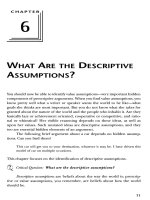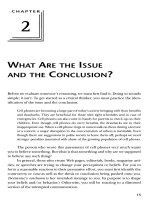Are the Strategic Stars Aligned for Your Corporate Brand
Bạn đang xem bản rút gọn của tài liệu. Xem và tải ngay bản đầy đủ của tài liệu tại đây (204.82 KB, 18 trang )
Are the Strategic Stars Aligned
for Your Corporate Brand?
Executive Summary
IN RECENT YEARS
, companies have increasingly seen
the benefits of creating a corporate brand. Rather than
spend marketing dollars on branding individual products,
giants like Disney and Microsoft promote a single um-
brella image that casts one glow over all their products.
A company must align three interdependent ele-
ments—call them strategic stars—to create a strong corpo-
rate brand: vision, culture, and image. Aligning the stars
takes concentrated managerial skill and will, the authors
say, because each element is driven by a different con-
stituency: management, employees, or stakeholders.
To effectively build a corporate brand, executives
must identify where their strategic stars fall out of line. The
authors offer a series of diagnostic questions designed to
reveal misalignments in corporate vision, culture, and
image. The first set of questions looks for gaps between
109
HBR033ch6 1/16/02 3:10 PM Page 109
110 Hatch and Schultz
vision and culture; for example, when management
establishes a vision that is too ambitious for the organiza-
tion to implement. The second set addresses culture and
image, uncovering possible gaps between the attitudes
of employees and the perceptions of the outside world.
The last set of questions explores the vision-image gap—is
management taking the company in a direction that its
stakeholders support?
The authors discuss the benefits of a corporate brand,
such as reducing marketing costs and building a sense of
community among customers. But they also point to
cases in which a corporate brand doesn’t make sense—
for instance, if you are a product incubator, if you’ve
recently experienced M&A activity, or if you are expect-
ing fallout from risky ventures.
W
sponsored the Juvenile
Diabetes Foundation in New York last year, the company
distributed the customary glossy promotional brochure
to highlight its generosity. That brochure, however,
looked different than those from years past. On the
cover, 20 of P&G’s flagship products were conspicuously
merged in a single symbolic image.
For the granddaddy of product branding, that image
may very well reflect a seismic shift in marketing strat-
egy. P&G was founded, after all, on the traditional mar-
keting notion that each product needs a unique identity.
Ideally, a brand would grow so strong that, like P&G’s
own Pampers, it would become a synonym for the prod-
uct itself.
If the image on the P&G brochure does imply a shift
in direction, the company will be joining the ranks of
corporate branding giants like Disney, Microsoft, and
HBR033ch6 1/16/02 3:10 PM Page 110
Sony. Rather than spend their marketing dollars on
branding individual products, those companies promote
a corporate brand—a single umbrella image that casts
one glow over a panoply of products. In recent years, cor-
porate brands have become enormously valuable
assets—companies with strong corporate brands can
have market values that are more than twice their book
values. (For more on the business case supporting corpo-
rate brands, see “What a Corporate Brand Can Do for
You” at the end of this article.)
Not surprisingly, creating a corporate brand is both
complicated and nuanced. Perhaps that’s why so many
companies get it wrong. In some cases, an organization
will invent a catchy new corporate slogan, tack it on a
wide range of products, and hope it will mean something
to employees and consumers alike. Just as bad, a com-
pany might simply design a new logo and slap it on every
product, hoping it will pass as a corporate brand. (See
“When a Corporate Brand Doesn’t Make Sense” at the
end of this article.)
But there is more to it than that. Our research into 100
companies around the world over ten years shows that a
company must align three essential, interdependent ele-
ments—call them strategic stars—to create a strong cor-
porate brand: vision, culture, and image. As opposed to
the shortcuts described above, aligning the stars takes
concentrated managerial skill and will. The reason is that
a different constituency—management, employees, or
stakeholders—drives each element. Consider:
•
Vision: top management’s aspirations for the com-
pany.
•
Culture: the organization’s values, behaviors, and
attitudes—that is, the way employees all through the
ranks feel about the company.
Are the Strategic Stars Aligned? 111
HBR033ch6 1/16/02 3:10 PM Page 111
•
Image: the outside world’s overall impression of the
company. This includes all stakeholders—customers,
shareholders, the media, the general public, and so on.
The Corporate Branding Tool Kit
To effectively build a corporate brand, executives need to
identify where their strategic stars fall out of line. To
guide managers through this analysis, we have developed
the corporate branding tool kit, a series of diagnostic
questions designed to reveal misalignments in corporate
vision, culture, and image. The first set of questions looks
at the relationship between vision and culture; that is,
how managers and employees are aligned. The second
set addresses culture and image, uncovering possible
gaps between the attitudes of employees and the percep-
tions of the outside world. The last set explores the
vision-image gap—is management taking the company
in a direction that its stakeholders support?
To get started, take a look at the exhibit “The Corpo-
rate Branding Tool Kit.” The questions are relatively
straightforward, but the investigation itself can be com-
plex and time-consuming. Culling all the relevant infor-
mation from your top managers, employees, and key
stakeholders—through interviews, focus groups, interac-
tive Web sites, and so on—can take months, or even a
year or more. Throughout the process, you’re trying to
detect misalignments between strategic vision, organiza-
tional culture, and stakeholder images—even small gaps
that might grow into larger ones.
Aligning the elements of your corporate brand is not a
sequential process. Vision, culture, and image are intri-
cately interwoven, and you need to conduct the gap anal-
yses concurrently. As you examine the relationship
112 Hatch and Schultz
HBR033ch6 1/16/02 3:10 PM Page 112
Who are your stakeholders?
What do your stakeholders want
from your company?
Are you effectively
communicating your vision
to your stakeholders?
Does your company practice
the values it promotes?
Does you company’s vision
inspire all its subcultures?
Are your vision and culture
differentiated from those of
your competitors?
What images do stakeholders
associate with your company?
In what ways do your employees
and stakeholders interact?
Do your employees care what
stakeholders think of the company?
Vision
(managers)
Culture
(employees)
Image
(stakeholders)
V
i
s
i
o
n
-
c
u
l
t
u
r
e
g
a
p
I
m
a
g
e
-
v
i
s
i
o
n
g
a
p
I
m
a
g
e
-
c
u
l
t
u
r
e
g
a
p
The Corporate Branding Tool Kit
To get the most out of a corporate branding strategy, three essential ele-
ments must be aligned: vision, culture, and image. Aligning these “strate-
gic stars” takes concentrated managerial skill and will. Each element is
driven by a different constituency:
•Vision
Top management’s
aspirations for the
company.
•Culture
The organization’s val-
ues, behaviors, and
attitudes—that is, the
way employees all
through the ranks feel
about the company
they are working for.
•Image
The outside world’s over-
all impression of the
company. This includes
all stakeholders—cus-
tomers, shareholders,
the media, the general
public, and so on.
HBR033ch6 1/16/02 3:10 PM Page 113
between, say, vision and image or image and culture,
there will be some overlap. Don’t worry. This is the natu-
ral result of the interdependence of the elements.
The tool is useful in identifying the key problem
areas—the vision-culture gap, the image-culture gap,
and the image-vision gap—but the hard work of develop-
ing specific solutions and implementing them belongs to
you and your team.
-
This misalignment develops when senior management
moves the company in a strategic direction that employ-
ees don’t understand or support. The gap usually
emerges when senior management establishes a vision
that is too ambitious for the organization to implement.
The main symptom: a breach between rhetoric and real-
ity. Disappointed managers often blame employees for
resisting change; frustrated employees react with cyni-
cism and suspicion. Such scapegoating and distrust are
extremely dangerous for companies. Like an ulcer, they
can eat away at a corporate brand from within. To
uncover possible gaps between vision and culture, man-
agers should ask the following questions of themselves
and their employees:
Does your company practice the values it promotes?
We all laugh at Dilbert cartoons. But a company where
every cubicle is festooned with them is probably in deep
trouble. The cartoons use cynical humor to point out the
discrepancies between the values a company espouses
and those that its systems promote. This isn’t a laughing
matter. During John Akers’s reign at IBM, for example, a
joke circulated throughout the company that “IBM
means I’ve been misled.” The severe downsizing that
114 Hatch and Schultz
HBR033ch6 1/16/02 3:10 PM Page 114
took place in the early 1990s in spite of the company’s
promises of lifelong employment had generated anxiety,
depression, and fear among its employees. Needless to
say, the effect of such disillusionment on IBM’s brand at
the time was devastating.
Does your company’s vision inspire all its subcul-
tures? Any company, large or small, is made up of sub-
cultures. The engineers in your R&D department will
have a different set of values and priorities than those
held by the sales and marketing department. Top
managers need to be sure that the vision that inspires
them—they, too, have a subculture—will resonate
throughout the company. A vision that speaks only
to the R&D staff will not inspire a company that is
dependent on salespeople. The key is to understand
what organizational values are shared across the com-
pany. Successful corporate visions pick up on those
shared values. Bang & Olufsen, the Danish audiovisual
company known for its distinctive product designs, for
instance, unifies its disparate workforce around a
Bauhaus-inspired tradition of simplicity.
Are your vision and culture sufficiently differentiated
from those of your competitors? Your vision and culture
are your signature. Together, they are a powerful tool in
helping you stand out from your competition. Apple is a
classic example of a company that successfully differen-
tiated its vision through its unique culture. Thanks to
Steve Jobs, Apple saw the potential of computers to
change people’s everyday lives. Jobs’s insight and enthu-
siasm attracted to Silicon Valley legions of young people
who equated Apple with a new way of life. These com-
puter enthusiasts not only created a culture that sup-
ported Apple as it grew but also altered the shape of the
computer industry forever.
Are the Strategic Stars Aligned? 115
HBR033ch6 1/16/02 3:10 PM Page 115









